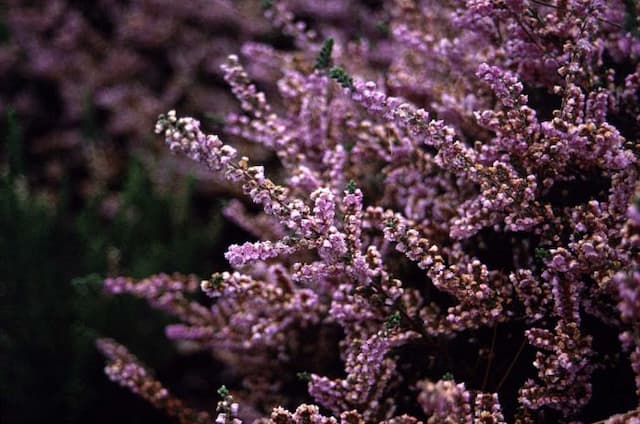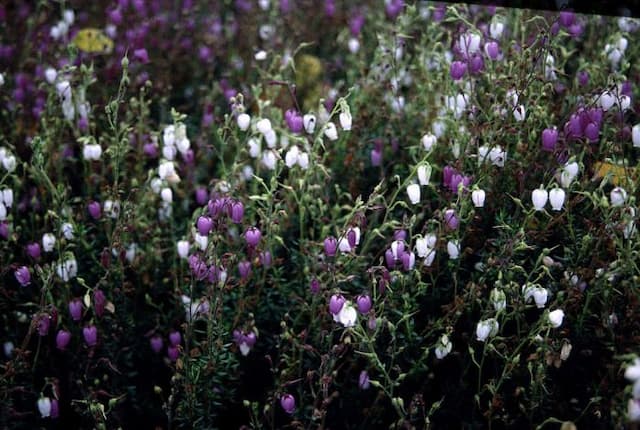White Enkianthus Enkianthus perulatus

ABOUT
Enkianthus perulatus, commonly known as the white enkianthus, is a deciduous shrub characterized by its distinctive and attractive appearance. The leaves of the white enkianthus are slender and oblong, with a smooth edge and a pointed tip, growing in an alternate pattern along the branches. Their color transitions from a bright green during the growing season to a vibrant display of reds, oranges, and yellows in the fall, providing a visually striking contrast. This plant is well-known for its bell-shaped flowers, which are a major highlight. The small, nodding flowers are usually white or pale pink with a slight greenish tinge and are elegantly arranged in clusters. These blooms are delicate in nature, each with a subtle, urn-like shape and hanging from the branches to provide a graceful display in the springtime. The bark of the white enkianthus is smooth and has a reddish-brown color, which adds interest to the garden even when the plant is not in flower. The overall form of the white enkianthus is elegant, with a well-branched structure that gives it a neat and tidy appearance throughout the year.
About this plant
 Names
NamesFamily
Ericaceae
Synonyms
White Enkianthus, White-Veined Enkianthus, Dodan-Tsutsuji
Common names
Enkianthus perulatus.
 Toxicity
ToxicityTo humans
White Enkianthus is not commonly known to be toxic to humans. There are no significant reports of toxicity or poisoning from ingesting parts of the White Enkianthus plant.
To pets
White Enkianthus is also not known to be toxic to pets. There is no substantial evidence indicating that ingestion of parts of the White Enkianthus plant could lead to poisoning or adverse health effects in pets.
 Characteristics
CharacteristicsLife cycle
Perennials
Foliage type
Deciduous
Color of leaves
Green
Flower color
White
Height
6 feet (1.83 meters)
Spread
4 feet (1.22 meters)
Plant type
Shrub
Hardiness zones
5
Native area
Japan
Benefits
 General Benefits
General Benefits- Aesthetic Appeal: Enkianthus perulatus, commonly known as the White Enkianthus, offers striking ornamental value with its bell-shaped white flowers and vibrant autumn foliage.
- Habitat Support: The plant provides food and shelter for various species of birds and insects, contributing to biodiversity.
- Landscape Design: Ideal for use in themed gardens, such as Japanese gardens or woodland settings, due to its naturalistic appearance and growth habit.
- Low Maintenance: Once established, the White Enkianthus is relatively low maintenance, requiring minimal care and pruning.
- Drought Resistance: The species can tolerate periods of dryness once mature, making it suitable for gardens with limited water availability.
- Seasonal Interest: It provides year-round interest with flowers in spring, lush greenery in summer, and vivid leaf colors in the fall.
 Medical Properties
Medical PropertiesThis plant is not used for medical purposes.
 Air-purifying Qualities
Air-purifying QualitiesThis plant is not specifically known for air purifying qualities.
 Other Uses
Other Uses- Water Purification: The roots of Enkianthus perulatus can be used in constructed wetlands for treating greywater, leveraging the plant's tolerance to heavy metals.
- Hobby Gardening: It is popular among enthusiasts for its aesthetic appeal due to its distinctive bell-shaped flowers and vibrant autumn leaf colors.
- Wildlife Habitat: Provides shelter and nesting sites for various bird species as well as insects within its foliage and branches.
- Educational Tool: Used in botanical studies due to its unique acid soil preference, aiding in the education of soil-plant relationships.
- Cultural Symbolism: In its native regions, it may be used in gardens to convey traditional symbolism or to celebrate certain seasons or festivals.
- Photography Subject: The plant’s striking appearance, especially during flowering and fall color change, makes it a favorite subject for nature photographers.
- Artistic Inspiration: Artists may choose the plant as a muse for paintings, drawings, and other forms of visual arts due to its intricate structure and beauty.
Interesting Facts
 Feng Shui
Feng ShuiThe White Vein Enkianthus is not used in Feng Shui practice.
 Zodiac Sign Compitability
Zodiac Sign CompitabilityThe White Vein Enkianthus is not used in astrology practice.
 Plant Symbolism
Plant Symbolism- Elegance: With its delicate bell-shaped flowers, Enkianthus perulatus, commonly known as "white enkianthus," represents elegance and grace.
- Renewal: As a plant that blooms in the spring, white enkianthus symbolizes new beginnings and the renewal of life.
- Adaptability: This plant can thrive in a variety of soil types, symbolizing the ability to adapt to different environments and circumstances.
- Simplicity: The simple and unassuming beauty of the white enkianthus reflects a value for harmony and minimalism.
 Water
WaterFor the Whitevein Enkianthus, it is best to water the plant deeply and allow the soil to become slightly dry between waterings. Ideally, you should water the plant with about 1 to 2 gallons of water every week during the growing season, while reducing the frequency in the winter months, as the plant's water needs decrease. Ensure that the water penetrates the soil deeply to encourage a strong root system but avoid oversaturating as this can lead to root rot. During particularly hot or dry spells, you may need to increase watering frequency.
 Light
LightWhitevein Enkianthus thrives in partial shade to full sun conditions. It is best planted in a spot where it can receive morning sunlight and afternoon shade, especially in areas with hot summers. This ensure that the plant gets a sufficient amount of light without being exposed to the intense heat of the midday sun.
 Temperature
TemperatureThe ideal temperature range for Whitevein Enkianthus is between 60 to 75 degrees Fahrenheit, though the plant can tolerate temperatures as low as 0 degrees Fahrenheit in winter. It can survive short periods of higher temperatures, but prolonged heat can stress the plant, so it should ideally be placed in a location where it can be shielded from extreme heat.
 Pruning
PruningPrune Whitevein Enkianthus in late winter or early spring to maintain its shape and encourage new growth. Cut back any dead or damaged branches, and thin out overcrowded areas to improve air circulation. Since this plant flowers on old wood, it's essential not to over-prune, as this can reduce the number of blooms in the following season. Pruning once a year is typically sufficient.
 Cleaning
CleaningNot needed
 Soil
SoilWhite Vein Enkianthus thrives in well-draining, acidic soil with a pH of 4.5 to 6. A mix of peat moss, sand, and pine bark suits it well, ensuring good aeration and moisture retention.
 Repotting
RepottingWhite Vein Enkianthus should be repotted every 2-3 years, or when it outgrows its current pot, to ensure continued health and growth.
 Humidity & Misting
Humidity & MistingWhite Vein Enkianthus prefers moderate to high humidity levels but is adaptable to average household humidity conditions.
 Suitable locations
Suitable locationsIndoor
Place in bright, indirect light and monitor soil moisture.
Outdoor
Provide partial shade and protect from harsh elements.
Hardiness zone
5-7 USDA
 Life cycle
Life cycleEnkianthus perulatus, commonly known as the white enkianthus, begins its life cycle as a seed that germinates in moist, well-drained soil with some shade. Once the seedling emerges and establishes its initial set of true leaves, it enters a slow-growing juvenile phase requiring partial sunlight and protection from extreme weather. The plant gradually matures into an adult shrub, exhibiting glossy green leaves and developing a woody stem structure over several years. During spring, mature white enkianthus produces clusters of bell-shaped white flowers, which are followed by the formation of dry, dehiscent capsules containing numerous small seeds. In autumn, the foliage undergoes a transformation, displaying vibrant fall colors before being shed for winter dormancy. After several reproductive cycles, the plant eventually senesces and dies, completing its life cycle, but not before dispersing seeds to give rise to the next generation.
 Propogation
PropogationPropogation time
Spring-Early Summer
Propogation: The Enkianthus perulatus, commonly known as White Enkianthus, is often propagated by seed, which is usually sown in fall immediately after ripening. However, the most popular method of propagation for this plant is by softwood cuttings. This method typically takes place in late spring or early summer when the new growth is still tender. To propagate by cuttings, a piece of the stem around 4 to 6 inches (approximately 10 to 15 centimeters) long is cut from the plant. The lower leaves are removed, and the cut end is often dipped in a rooting hormone to increase the chances of success. The cutting is then placed in a well-draining potting mix and kept under high humidity and indirect light until roots develop. This process typically takes several weeks to a few months, after which the new plant can be transplanted into the garden.









